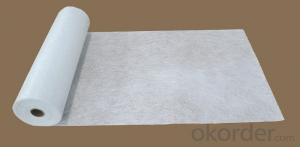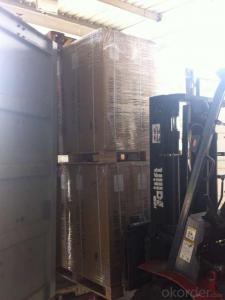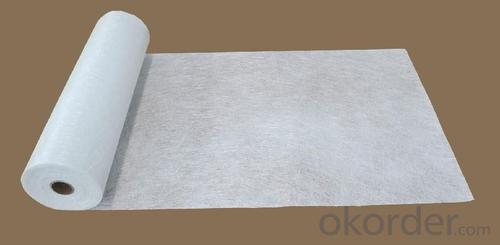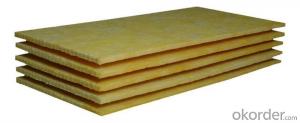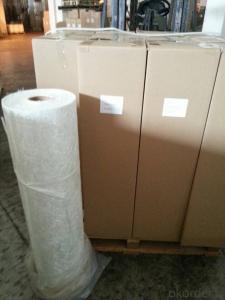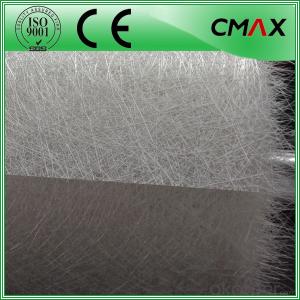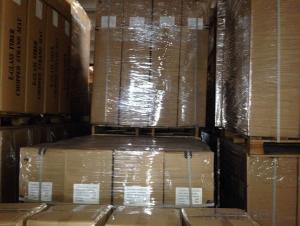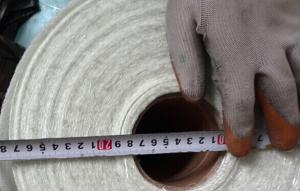Fiberglass Mat Tissue Chopped Strand Mat with Emulsion Binder
- Loading Port:
- Shanghai
- Payment Terms:
- TT OR LC
- Min Order Qty:
- 20000 kg
- Supply Capability:
- 200000 kg/month
OKorder Service Pledge
OKorder Financial Service
You Might Also Like
1.Brief Introductions
It is designed for use in hand lay-up, filament winding, compression molding and continuous laminating processes. Its end-use applications include boats, bath equipment, automotive parts, chemical corrosion resistant pipes, tanks, cooling towers and building components
2.Product Features
Fast breakdown in styrene
High tensile strength, allowing for use in hand lay-up process to produce large-area parts
Good wet-through and fast wet-out in resins, rapid air lease
3.Product Specifications
Property | Area Weight | Moisture Content | Size Content | Breakage Strength | Width |
(%) | (%) | (%) | (N) | (mm) | |
Mathods | IS03374 | ISO3344 | ISO1887 | ISO3342 | |
EMC80E | ±7.5 | ≤0.20 | 8-12 | ≥40 | 50-3300 |
EMC100E | ≥40 | ||||
EMC120E | ≥50 | ||||
EMC150E | 4-8 | ≥50 | |||
EMC180E | ≥60 | ||||
EMC200E | ≥60 | ||||
EMC225E | ≥60 | ||||
EMC300E | 3-4 | ≥90 | |||
EMC450E | ≥120 | ||||
EMC600E | ≥150 | ||||
EMC900E | ≥200 |
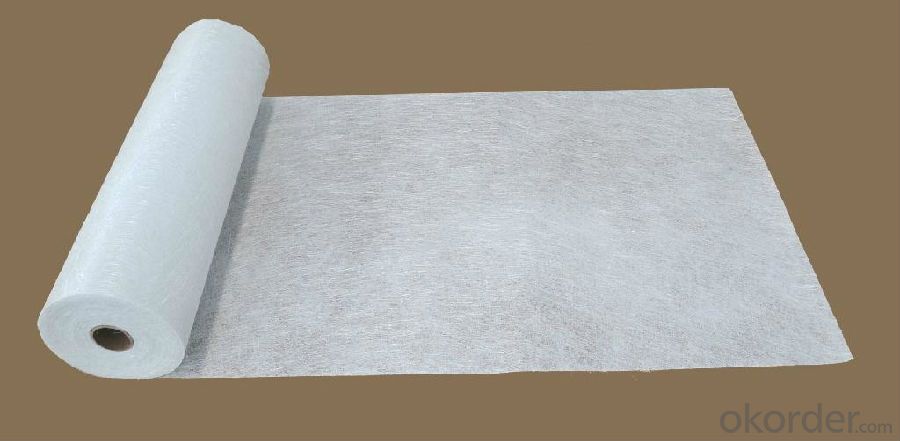
4.FAQ
Packaging:
Each Chopped Strand Mat is wound onto a paper tube which has an inside diameter of 76mm and the mat roll has a diameter of 275mm. The mat roll is wrapped up with plastic film,and then packed in a cardboard box or wrapped up with kraft paper. The rolls can be vertically or horizontally placed. For transportation, the rolls can be loaded into a cantainer directly or on pallets.
Delivery Time:
10-20 days after getting the down payment or original acceptable L/C.
- Q: How is fiberglass mat tissue used in the production of sports equipment?
- Fiberglass mat tissue is used in the production of sports equipment as it provides strength, flexibility, and durability to the final product. It is commonly used as a reinforcement material in the manufacturing of sports equipment such as snowboards, surfboards, hockey sticks, and tennis rackets. The fiberglass mat tissue is typically layered with resin and other materials, forming a composite structure that enhances the overall performance and longevity of the sports equipment.
- Q: Is fiberglass mat tissue suitable for insulation in hospitals?
- Yes, fiberglass mat tissue is suitable for insulation in hospitals. It provides excellent thermal insulation properties and is fire-resistant, which is crucial for ensuring the safety of patients and staff in healthcare environments. Additionally, fiberglass mat tissue is a durable and cost-effective option for insulation, making it a practical choice for hospitals.
- Q: How does the density of fiberglass mat tissue impact its performance?
- The density of fiberglass mat tissue significantly affects its performance. Fiberglass mat tissue is a nonwoven material composed of randomly dispersed glass fibers held together by a binder. The density of the tissue refers to the amount of fibers present in a given volume of the material. A higher density of fiberglass mat tissue generally results in improved mechanical properties and performance. The increased density means that there are more glass fibers per unit volume, leading to enhanced strength, stiffness, and durability. This makes the material more resistant to tearing, puncturing, and abrasion, which is particularly important in applications where the tissue is exposed to harsh conditions or heavy loads. Moreover, a higher-density fiberglass mat tissue offers better thermal insulation properties. The increased fiber content allows for better heat resistance, making it suitable for applications that require thermal protection, such as insulation boards or fireproofing materials. On the other hand, a lower density of fiberglass mat tissue may provide advantages in certain applications. Lower-density tissues are generally more flexible and have better conformability, allowing them to easily adapt to irregular surfaces or complex shapes. This makes them suitable for applications where flexibility or conformability is a primary requirement, such as in automotive or aerospace industries. Overall, the density of fiberglass mat tissue plays a crucial role in determining its performance characteristics. Whether a higher or lower density is preferred depends on the specific application requirements, considering factors such as strength, stiffness, durability, thermal insulation, flexibility, and conformability.
- Q: What is the expected lifespan of fiberglass mat tissue in underground applications?
- The expected lifespan of fiberglass mat tissue in underground applications can vary depending on various factors such as the specific conditions of the underground environment, the quality and thickness of the fiberglass mat tissue, and the level of maintenance and care provided. However, on average, fiberglass mat tissue is known for its durability and longevity, making it suitable for underground applications. In general, fiberglass mat tissue is designed to be highly resistant to corrosion, moisture, and other environmental elements commonly found in underground settings. This makes it a reliable choice for applications such as underground pipes, tanks, and other infrastructure where protection against deterioration is crucial. With proper installation and regular maintenance, fiberglass mat tissue can have an expected lifespan of 50 years or more in underground applications. However, it is essential to note that this estimate can vary depending on the specific conditions and usage of the fiberglass mat tissue. To ensure the maximum lifespan of fiberglass mat tissue in underground applications, it is recommended to follow industry best practices, such as proper installation techniques, regular inspections, and addressing any issues, such as cracks or damage promptly. By doing so, the lifespan of fiberglass mat tissue can be extended, providing long-term reliability and durability in underground settings.
- Q: Is fiberglass mat tissue suitable for insulation in educational facilities?
- Indeed, fiberglass mat tissue proves to be a suitable option for insulation in educational facilities. Owing to its exceptional thermal insulation properties, fiberglass mat tissue is widely employed in insulation applications. This lightweight and cost-effective material effectively insulates buildings, including educational facilities, from heat loss or gain. Moreover, fiberglass mat tissue is renowned for its fire-resistant characteristics – a vital consideration in any structure, particularly in educational facilities where the safety of students and staff takes precedence. Furthermore, the installation of fiberglass mat tissue is effortless, and it does not necessitate extensive upkeep, thus rendering it a convenient selection for insulation in educational facilities.
- Q: How does fiberglass mat tissue compare to mineral wool insulation?
- Construction and other industries commonly use fiberglass mat tissue and mineral wool insulation as insulation materials. While both serve the purpose of providing thermal insulation, there are differences between them. Fiberglass mat tissue consists of bonded fine glass fibers that form a lightweight and flexible mat. This makes it easy to handle and install. It is also resistant to moisture, mold, and pests, making it a durable option. Its high R-value, which measures heat flow resistance, makes it an effective insulator. On the other hand, mineral wool insulation is made from natural minerals like basalt, diabase, or slag. It is usually denser and heavier than fiberglass mat tissue. Mineral wool insulation has excellent fire resistance properties and can withstand high temperatures. It also provides sound insulation, reducing noise transmission. However, it can absorb moisture, which may decrease its effectiveness over time. Both materials offer similar levels of insulation in terms of thermal performance. However, fiberglass mat tissue is slightly more efficient due to its higher R-value. Additionally, it is generally more affordable compared to mineral wool insulation. In conclusion, fiberglass mat tissue and mineral wool insulation are both effective insulation materials. The choice between them depends on specific project requirements, such as fire resistance, sound insulation, cost, and moisture resistance. It is crucial to consider these factors and seek professional advice to determine the most suitable insulation material for a particular application.
- Q: What is the delamination strength of fiberglass mat tissue?
- The ability of fiberglass mat tissue to resist the separation or detachment of its layers, known as delamination strength, is influenced by various factors. These factors include the quality of the resin used, the thickness and density of the mat, and the manufacturing process. To ensure durability and structural integrity, fiberglass mat tissue is typically designed with a high delamination strength. It is composed of multiple layers of glass fibers held together by a binder or resin. The bonding between these layers is crucial in preventing delamination. Various testing methods, such as the peel test, can determine the delamination strength of fiberglass mat tissue. This test measures the force required to separate the layers and provides valuable information about the adhesive strength between them, helping to assess the material's overall quality. The delamination strength may vary depending on the specific application and requirements. Different industries, such as construction, automotive, marine, and aerospace, may have different delamination strength specifications for their fiberglass mat tissue. Manufacturers typically provide technical data or specifications indicating the delamination strength of their products. It is important to consider external factors that can influence the delamination strength of fiberglass mat tissue, such as exposure to extreme temperatures, moisture, or chemical substances. Proper installation, maintenance, and adherence to recommended usage guidelines are crucial in maintaining the desired delamination strength and overall performance of the material.
- Q: Can fiberglass mat tissue be used in structural applications?
- Yes, fiberglass mat tissue can be used in structural applications. Fiberglass mat tissue is a lightweight and flexible material that is commonly used as reinforcement in construction and engineering. It is often used in conjunction with other materials such as resin or concrete to enhance the structural integrity of various components. The high strength-to-weight ratio of fiberglass mat tissue makes it ideal for reinforcing structures such as walls, roofs, and floors. Additionally, fiberglass mat tissue is resistant to corrosion, moisture, and chemicals, making it suitable for use in various environments. Its versatility and durability make it a popular choice in structural applications.
- Q: Can fiberglass mat tissue be used for insulation in hot climates?
- Certainly! Fiberglass mat tissue is applicable for insulation purposes in hot climates. Fiberglass possesses remarkable thermal insulation characteristics that render it suitable for both cold and hot environments. In hot climates, fiberglass insulation effectively impedes the transmission of heat from the external to the internal areas of a structure, thereby ensuring a pleasant indoor temperature. It functions as a shield by minimizing the conduction, convection, and radiation of heat. Moreover, fiberglass insulation exhibits fire resistance, durability, and non-absorbency, thus establishing itself as an optimal option for insulation in hot climates.
- Q: What is the thermal stability of fiberglass mat tissue?
- The thermal stability of fiberglass mat tissue refers to its ability to withstand high temperatures without experiencing significant degradation or loss of its physical properties. Fiberglass mat tissue is typically made from woven or non-woven glass fibers, which are known for their excellent thermal resistance. Fiberglass mat tissue can typically withstand temperatures ranging from around 100°C (212°F) to 500°C (932°F) depending on the specific type and composition. At these temperatures, the glass fibers maintain their strength, dimensional stability, and insulation properties. The thermal stability of fiberglass mat tissue is important in various applications where exposure to high temperatures is expected. For example, it is commonly used in the construction industry for insulation purposes in buildings, as it is capable of withstanding the heat generated by HVAC systems or fire. In addition, the thermal stability of fiberglass mat tissue is also crucial in industries such as automotive, aerospace, and marine, where it is used for heat shielding, fire protection, and insulation in engine compartments, exhaust systems, and other high-temperature environments. Overall, the thermal stability of fiberglass mat tissue makes it a reliable and durable material choice for applications requiring resistance to high temperatures. Its ability to maintain its properties under extreme heat conditions ensures long-lasting performance and safety in various industries.
Send your message to us
Fiberglass Mat Tissue Chopped Strand Mat with Emulsion Binder
- Loading Port:
- Shanghai
- Payment Terms:
- TT OR LC
- Min Order Qty:
- 20000 kg
- Supply Capability:
- 200000 kg/month
OKorder Service Pledge
OKorder Financial Service
Similar products
Hot products
Hot Searches
Related keywords
